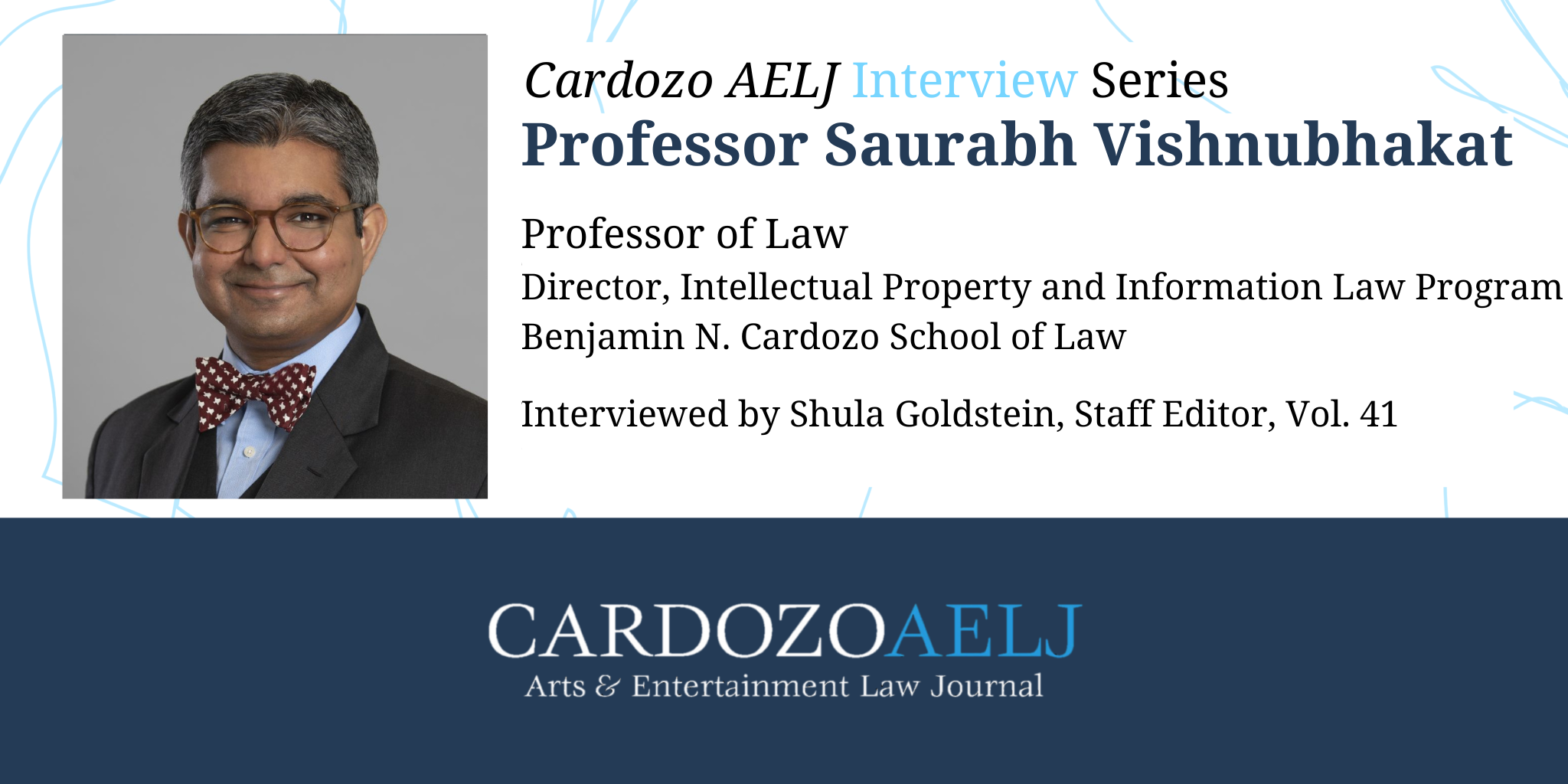Cardozo AELJ Interview Series: Professor Saurabh Vishnubhakat
ByOnline Editor
- On
In this interview, Cardozo Professor Saurabh Vishnubhakat discusses what he hopes to bring to Cardozo as the new Director of Intellectual Property and Information Law Program, his professional background, and what drew him to the field of intellectual property.
Saurabh Vishnubhakat is a Professor of Law and Director of the Intellectual Property and Information Law Program at Cardozo Law. He is also a Research Fellow at the Duke Law Center for Innovation Policy and a Senior Scholar at the George Mason University Center for IP and Innovation Policy. Professor Vishnubhakat writes and teaches in intellectual property, administrative law and federal litigation, especially from an empirical perspective. His research explores the interaction of the U.S. intellectual property system with federal courts and agencies and with markets for technology. His work has been cited in federal judicial opinions, agency regulations, and over thirty appellate briefs in the Supreme Court and Federal Circuit.
Our interview with Professor Vishnubhakat was conducted by Shula Goldstein. Shula is a Third Year Law Student at the Benjamin N. Cardozo School of Law. Shula is interested in entertainment law and intellectual property.
SG: As the new Director of the IP & Information Law program, what do you hope to bring to the program and to Cardozo as a whole?
PV: First and foremost, enthusiasm! It’s bittersweet to take the handoff from Professor Buccafusco, who has been a generous friend and colleague to me from my start in academia, and he has set a high standard. So, in the short term, I hope to bring fresh eyes to what the IP & Information Law program already does well, from academic conferences and colloquia to student seminars and career planning.
In that endeavor, what success looks like is that the legal community—both here in New York and around the country—will become more aware of all that terrific programming. I want IP lawyers to be excited about when our next event will be, and I want IP firms to be excited that our students are applying to them for internships and jobs.
SG: What led to your desire to work at Cardozo?
PV: Decisions like this often depend on luck and timing. That is especially true when you have a job you love at a terrific school, as I did at Texas A&M for seven years. Our decision began with a desire to be closer to family while staying connected to a home for world-class research and teaching in the areas of intellectual property and innovation. Few law schools play at that level, and Cardozo is one of them. It helped that I already knew Cardozo’s IP faculty—indeed, many non-IP faculty as well—from conferences and other academic interactions. From there, it doesn’t take long to discover what a genuine community this is.
SG: Last semester you taught a course on IP Policymaking. What do you hope that students gained from the class?
PV: IP Policymaking takes existing law as simply a starting point and asks bigger questions about how society should look, how markets should function, and how government can be a force for good. The lawyerly skills of careful research and cogent persuasion are as important as ever, but the course also prioritizes creativity and consensus-building. It is a seminar format where we not only critique each other’s arguments but also challenge each other’s very goals and policy values. As a result, I hope students take away the sense of camaraderie and respect that lobbyists and other advocates develop even for people on the other side, including the age-old lesson that you often learn more from your opponents than from your friends.
SG: I see that you took three years between earning your bachelor’s degree in chemistry from Georgia Institute of Technology and starting law school at the University of New Hampshire. What did you do during your time leading up to law school?
PV: A few different things, but two experiences were especially formative. I briefly continued my studies in chemistry as a graduate student before discovering that my interests and abilities lay elsewhere. And I worked in local politics, including a state house where the candidate was the father of one of my friends from high school. That was a valuable lesson in discovering how to invest meaningfully in the future of one’s own community.
SG: Was there one particular experience that piqued your interest in the field of intellectual property law?
PV: I think law in general and intellectual property in particular were lurking in a liminal space for me for a long time. It wasn’t any one experience. My STEM background meant that I came to intellectual property first by way of patent law, not copyright or trademark as many others do. That entry point also informed my choice of law school: Franklin Pierce Law Center (now the UNH Franklin Pierce School of Law), which has long been a leader in that field. Studying IP at Pierce Law gave me as full a picture of the field as I could have asked for.
SG: You worked at the US Patent and Trademark Office for a number of years prior to joining academia. What was the primary reason for your switch from government service to academia?
PV: I was always bound for academia. Ever since I was a child, I have thought that being a teacher was the highest calling someone could have. When I joined the USPTO after law school, it was a particular group within the agency: the Office of the Chief Economist. At the time, it was newly created and was charged with serving as a sort of internal think tank for the Under Secretary and other agency leadership. At times, the work was quite academic in nature, and even the raw public policy was organized around innovative research by scholars of law, industrial organization, resource economics, and other related fields. It seemed to me a great springboard for an eventual career in academia, and so it proved.
SG: How did your experience at the US Patent and Trademark Office influence your advocacy and policymaking engagement?
PV: In many more ways than I could catalogue, I’m sure, but two lessons stand out. One is that much of my work is empirical in nature. Sometimes that means it is quantitative—collecting data, tabulating statistics, and running regressions—but not always. Good empirical research is aimed at answering specific questions about how a particular corner of the world really works in practice. It often means identifying an assumption that we might take completely for granted and interrogating its validity, which can be an exciting endeavor.
The other is that the research questions I find interesting are often questions that important institutions would find interesting, whether it be a court or an agency, a sector of the market or a segment of the public. Once in a while, my answers to many practical questions might add up to a larger theoretical conclusion, offering a wholesale change in perspective. But with or without that, the practical questions that I usually explore keep me connected to the world of policy advocacy.
SG: In the amicus briefs you submitted in Thryv, Inc. v. Click-To-Call Technologies, LP and Wi-Fi One, LLC v. Broadcom Corporation, No. 15–1944, -1945, – 1946 you touch on the importance of statutory constraints on using the U.S. Patent and Trademark Office Patent Trial and Appeal Board (“PTAB”) as a substitute for courts in re-evaluating patent validity. Can you please elaborate on how PTAB is used in this manner, the statutory constraints, and why those constraints are so important?
PV: Thryv and Wi-Fi One were both about judicial review. When the Patent Office wrongly refuses to grant a patent to a deserving inventor, she can appeal that mistake. But when the Patent Office wrongly agrees to grant an undeserved patent, there is no corresponding appeal available to fix that mistake. Patents are powerful legal instruments, so having wrongly issued patents out in the world can be a recipe for mischief—and for a long time, courts were the only place where such mischief could be curbed. Starting in the early 1980s, Congress began shifting some of that corrective power back into the USPTO, the agency that made the mistake in the first place. By the time PTAB review proceedings had been created in 2011, those administrative powers of correction were quite strong.
Now consider the implications of strong administrative agency power, especially when it is being wielded against a legal right as potent and valuable as a patent. It brings greater expertise to the table but also injects political influence, and so the need for judicial oversight becomes more salient. For several years after the PTAB review proceedings came into effect, the U.S. Court of Appeals for the Federal Circuit (which exclusively hears all patent-related appeals) had held that certain threshold decisions of the PTAB were judicially unreviewable. Wi-Fi One was an en banc Federal Circuit decision reversing that doctrine—correctly, in my view. Wi-Fi One never went up to the Supreme Court, but a couple of years later, in a different case, Thryv, the Supreme Court took up the same question and reversed course yet again.
The basic dispute is over who should have the last word: a democratically accountable but politically changeable agency, or federal courts whose lifetime tenure and other features are supposed to insulate them from the instability of popular politics. Answering that question depends on whether you see patents as property rights requiring stability or government favors with political risk baked into them.
SG: What issue in the field of IP law do you feel is the most pressing for policymaking?
PV: If the question is about how IP law can keep pace with technological change, I would point to the growing abilities of natural language processing, machine learning, and other artificial intelligence-like systems to emulate the inventive processes at the heart of patent law or the creative processes at the heart of copyright. Alternatively, if the question is about how IP law as a system of social organization can channel investments with efficiency and credibility, then I would probably use the age-old law professor trick of moving the goalposts. Don’t ask, what is the right answer? Ask instead, who should get to decide?




